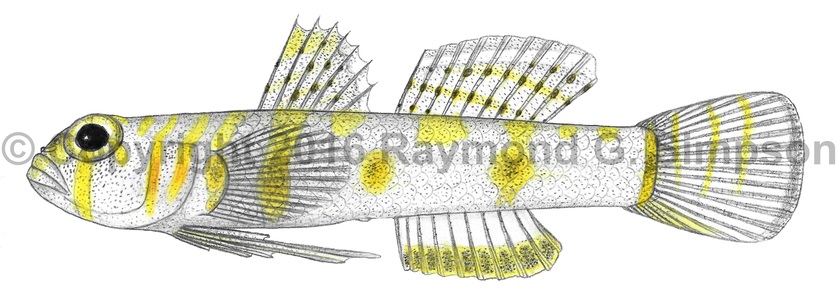
Common Name
Spotted-sail Goby
Year Described
Van Tassell, Baldwin & Gilmore, 2016
Identification
Dorsal Fin: VII, 9
Anal Fin: 7-8
Pectoral Fin: 17-18
Caudal Fin: 16-17 segmented rays
Vertebrae: 11+16= 27 (total)
Body elongate with a large head. Eye medium sized. Dorsal fin with anterior spines not elongate and last two spines more spaced than the first five. Pelvic fin rays un-branched or branched and re-fused, with the last much shorter than fourth and unbranched. Pelvic rays with flat, fleshy tips. Pelvic fins not fused; extending to past anal fin base. One anal-fin pterygiophore anterior to the first haemal spine. Papillae rows 5i and 5s are connected as a single row. Cephalic lateralis pores absent. Body scaled anteriorly in a wedge extending to the pectoral base (23-34 rows). Two basicaudal scales present.
Color
Body whitish with two rows of yellow blotches: seven smaller blotches on the dorsum and three lateral blotches. The anterior and posterior middle blotches are fused with the upper blotches and continue to the ventrum as bands. These full bands are more brownish-gold. Base of tail with a brownish-gold vertical band. Three yellow bands behind head and one yellow band through the eye. Eye yellow. Fresh specimens with opalescent white markings. Dorsal fins with oblique lines of dark spots or yellow spots, or both. Margins of dorsal fin opalescent white. Caudal fin bright white with two vertical bands and a yellow lower lobe. Anal fin yellowish with a dark margin. Pectoral and pelvic fins pale yellow to clear.
Size
Maximum size to 45mm SL.
Habitat
Taken between 152-288m on sand and rubble bottoms.
Range
Known from the Caribbean islands: the Bahamas, Curacao, and Tobago.
References
Tornabene, L., J.L. Van Tassell, R.G. Gilmore, D.R. Robertson, F. Young, & C.C. Baldwin. 2016. Molecular phylogeny, analysis of character evolution, and submersible collections enable a new classification of a diverse group of gobies (Teleostei: Gobiidae: Nes subgroup), including nine new species and four new genera. Zoological Journal of the Linnean Society.